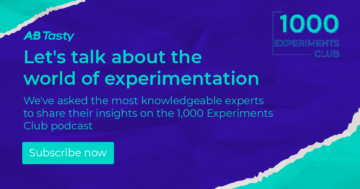Ben Labay outlines essential frameworks for a more strategic, tactical and disruptive approach to experimentation
With two degrees, in Evolutionary Behavior and Conservation Research Science, Ben Labay spent a decade in academia with a wide-ranging background in research and experimentation dealing with technical data work.
Now as CEO of experimentation and conversion optimization agency Speero, Ben describes his work in experimentation as his “geek-out” area which is customer experience research and dealing with customer data.
At Speero, Ben works to scope and run research and test program strategies for companies including Procter & Gamble, ADP, Codecademy, MongoDB, Toast and many others around the world.
AB Tasty’s VP Marketing Marylin Montoya spoke with Ben on how to create mechanisms for companies to not only optimize but also be more disruptive when it comes to web experimentation to drive growth.
Here are some of the key takeaways from their conversation.
Consider a portfolio way of management in experimentation
Inspired by Jim Collins’ and Jerry I. Porras’ book “Built to Last”, Ben discusses a framework that the book provides on the ways a company can grow based on the best practices from 18 successful companies.
He identifies one big pillar that many organizations are often neglecting: experimentation. To tackle this, Ben suggests taking a portfolio management way of doing experimentation made up of three portfolio tags which provide a solution spectrum around iterative changes for optimization.
The first level consists of making small tweaks or changes to a website based on customer feedback such as improving layouts and the second which includes more substantial types of changes such as new content pieces.
But there’s a bigger third level which Ben refers to as more “disruptive” and “innovative” such as a brand new product or pricing model that can serve as a massive learning experience.
With three different levels of change, it’s important to set a clear distribution of time spent on each level and have alignment among your team.
In the words of Ben, “Let’s put 20% of our calories over into iterating, 20% onto substantial and 20/30/ or 40% over on disruptive. And that map – that framework has been really healthy to use as a tool to get teams on the same page.”
For Ben, applying such a framework is key to getting all teams on the same page as it helps ensure companies are not under-resourcing disruptive and “big needle movers”. Velocity of work is important, he argues, but so is quality of ideas.
Let your goal tree map guide you
Every A/B test or personalization campaign needs to be fed with good ingredients which determine the quality of the hypothesis.
“Every agency, every in-house company researches. We do research. We collect data, we have information, we get insights and then they test on insights. But you can’t stop there.” Ben says.
The trick is not to stop at the insights part but to actually derive a theme based on those insights. This will allow companies to pick underlying strengths and weaknesses to map them into their OKRs.
For example, you may have a number of insights like a page underperforming, users are confused about pricing and social proof gets skipped over. The key is to conduct a thematic analysis and look for patterns based on these different insights.
Consequently, it’s important for companies to create a goal tree map to help them understand how things cascade down and to become more tactical and SMART about their goals and set their OKRs accordingly to organize and make sense of the vast amount of data.
When the time comes to set up a testing program, teams will have a strategic testing roadmap for a particular theme that links to these OKRs. This helps transform the metrics into more actionable frameworks.
And at the end of each quarter, companies can evaluate their performance based on this scorecard of metrics and how the tests they ran during the quarter impacted these metrics.
Build engagement and efficiency into your testing program strategy
The main value prop of testing centers around making profit but Ben advocates for a second value prop which revolves around how a business operates. This requires shifting focus to efficiency and how different teams across an organization work together.
Ben parallels the A/B testing industry with Devops as it strives to bring in elements from the DevOps cultural movement when we refer to a culture of experimentation and being data-driven. In many ways, this echoes the DevOps methodology, which is focused on breaking down silos between development and operation teams to enhance collaboration and efficiency between these teams. “The whole idea is to optimize the efficiency of a big team working together”, Ben says.
This means organizations should take a hard look at their testing program and the components that make up the program which includes getting the right people behind it. It’s also about becoming more customer-centric and embracing failure.
Ben refers to this as the “programmatic side” of the program which serves as the framework or blueprint for decision making. It helps to answer questions like “how do I organize my team structure?” or “what is my meeting cadence with the team?”
Ultimately, it’s about changing and challenging your current process and transforming your culture internally by engaging your team within testing your program and the way you’re using data to make decisions.
What else can you learn from our conversation with Ben Labay?
- Ways to get out of a testing rut
- How to structure experimentation meetings to tackle roadblocks
- How experimentation relates to game theory
- The importance of adopting a actionable framework for decision making
About Ben Labay
Ben Labay combines years of academic and statistics training with customer experience and UX knowledge. Currently, Ben is the CEO at Speero. With two degrees in Evolutionary Behavior and Conservation Research Science (resource management), Ben started his career in academia, working as a staff researcher at the University of Texas focused on research and data modeling. This helped form the foundation for his current passion and work at Speero, which focuses on helping organizations make decisions using customer data.
About 1,000 Experiments Club
The 1,000 Experiments Club is an AB Tasty-produced podcast hosted by Marylin Montoya, VP of Marketing at AB Tasty. Join Marylin and the Marketing team as they sit down with the most knowledgeable experts in the world of experimentation to uncover their insights on what it takes to build and run successful experimentation programs.








